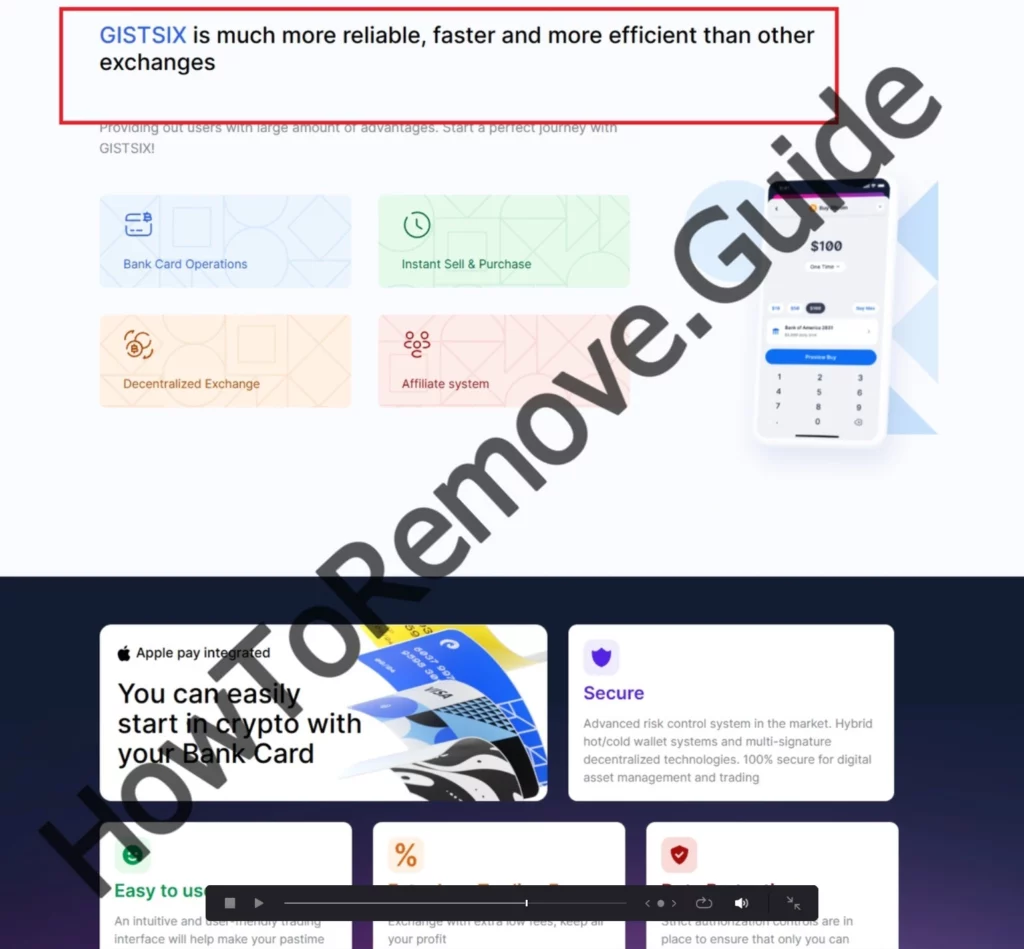The promise of quick investment returns and large profits associated with cryptocurrency has made millions of people try their hand at the crypto market in past years. However, too few have a good understanding of how crypto works and that’s why scams related to cryptocurrency transactions are so prevalent and so successful.
Gistsix yet is another example of a scam website that poses as a legitimate crypto exchange platform that steals the money of anyone who falls for its lies. It’s similar to other fake Bitcoin sites we’ve seen in the past – Onsomo.com, Jewzee.com, etc., so we’ve got a pretty good idea of how they function. This page will tell you all you need to know about Gistsix.com in order to stay safe.
What is the Gistsix Scam?
The Gistsix scam, like most other Bitcoin scams, follows a familiar pattern. It funnels you in through a deceptive social media post from a fake profile of a celebrity or another high-profile figure. Fake Elon Musk Twitter/X accounts are a prime example of that.
The post announces a generous BTC giveaway – a set amount of people who first click the link in the post and register will be rewarded a hefty amount of coins “for free”. The promised amount is typically along the lines of 0.3 BTC which roughly equals 90,000 USD.

If you click the link and visit the Gistsix page, you are asked to send a relatively small deposit in order to claim the reward. By “small” we mean a couple of hundred dollars in BTC.
By this time the scam should be obvious – you send the deposit and then find out you can’t withdraw the reward. Not only that, you also can’t get your deposit back. You’ve been scammed.
Hopefully, you are not among the many who’ve fallen for this scheme, but even if you have, I still strongly recommend reading the next lines because they can be very helpful in preventing future problems linked to crypto scams.
What to Do If You’ve Fallen for the Gistsix Cryptocurrency Scam
I should straightaway say that you don’t have a very high chance of getting your money back. I still suggest reporting that scam – in rare cases, this could eventually restore your money. However, don’t get your hopes too high.
That said, there are absolutely follow-up actions that you must perform to prevent further complications.
The loss of some 300-400 dollars is nothing compared to what can happen next if you don’t act quickly. Here’s what I suggest you do next:
1. Revise All Passwords Across Relevant Accounts
Changing every password tied to accounts used for cryptocurrency is vital. Simple, easily guessed patterns create weak points. Instead, unique, complex combinations work best. Password managers can help store and generate strong passwords. Securing accounts with diverse and complicated passwords makes unauthorized access more difficult.
2. Enable Two-Factor Authentication (2FA)
Two-factor authentication (2FA) offers essential protection beyond standard passwords. App-based 2FA methods, such as Google Authenticator or Authy, work better than SMS, making interception harder for scammers. Major platforms now support 2FA, adding a crucial barrier against unauthorized access. Enable 2FA to add a second security layer to your accounts.
3. Report the Scam to Relevant Authorities
Reporting the scam matters. Contact the platform where the scam appeared, whether a social media site or a crypto exchange. National cybercrime agencies also accept these reports. Though they may not retrieve lost funds, reports help track and disrupt fraudulent operations, reducing future harm. Reporting assists others by hindering scammers’ activities.
4. Keep an Eye on Your Accounts for Suspicious Activity
Monitoring accounts becomes crucial after a scam. Unusual transactions or unfamiliar activities may signal further attempts at unauthorized access. Report anything suspicious immediately. Quick action can stop additional losses and keep your remaining assets safe.

Techniques Used by the Gistsix Scam
Knowledge is the ultimate tool against scams like Gistsix. There are some pretty creative techniques that they use to get you to believe their fake claims, so you need to be well aware of how they trick you in order to stay safe in the future. Here are the most common deceptive techniques used by Gistsix and other similar scams:
Fake Celebrity Endorsements
Fake celebrity endorsements prove effective for Gistsix. Scammers replicate profiles or fabricate deepfake videos, creating illusions that high-profile figures back the offer. Most people tend to trust well-known individuals, making the scheme more persuasive. But appearances deceive.
Verify endorsements by checking official profiles. Authentic accounts display a blue verification mark. Fake accounts often lack consistent posting histories or have strange usernames. Watch for subtle errors that may reveal the scam.
Promises of Guaranteed Profits
Guaranteed profits in cryptocurrency serve as bait. Scammers use phrases like “500% returns” or “double your money in a week” to attract victims. Cryptocurrency markets remain volatile, making guaranteed returns impossible. Any promise of such returns indicates a scam. The allure of easy profit misleads, yet reality tells a different story.
Phishing Websites Mimicking Real Platforms
Fake websites that look like popular crypto platforms trick users into submitting login credentials or depositing funds. URLs differ from the real ones only slightly, making them easy to miss. The design mirrors legitimate platforms, creating a convincing front.
Examining URLs closely becomes critical. Bookmarking verified sites avoids mistakes. Avoid following links from emails or social media; these often lead directly to phishing pages. Recognizing fake websites takes attention but prevents unauthorized access to accounts.
Creating a Sense of Urgency or FOMO
Creating urgency pushes victims to act quickly. Scammers invoke FOMO (fear of missing out) with statements like “limited-time offer,” pressuring users to skip due diligence. Urgency persuades individuals to make rash decisions.
Reliable offers don’t rely on urgency. Pause before committing to any opportunity that demands immediate action. Scammers thrive on rushed choices, knowing that a moment’s hesitation might reveal the truth.
The Gistsix Bitcoin Scam- Red Flags
Once you know what the signs of a crypto scam are, it becomes infinitely easier to spot it and avoid it. Be sure to familiarize yourself with the next red flags and always check for them when you come across a suspicious online offer. If you notice even a single one of these next characteristics, ignore the offer and move on with your day.
Unrealistic Promises of Guaranteed Profits
Guarantees of profit contradict crypto’s unpredictable nature. Markets change, and no legitimate source can promise steady returns. Assurances like “100% profit” or “double your money” signal deception. Scammers use unrealistic promises to catch the attention of those wanting quick profits.
Requests for Upfront Fees
Requests for fees before receiving a reward raise red flags. Scammers often ask for a “transaction fee” or “entry fee” as a prerequisite for accessing funds. Authentic crypto platforms rarely, if ever, request such upfront payments. Any mention of a fee before payment signals a scam.
Fake Endorsements from Public Figures
Public figures rarely endorse unsolicited offers. When scammers attach these endorsements, they aim to create credibility. Official channels verify real endorsements, helping distinguish genuine support from deception. Checking claims avoids falling for fake endorsements.
Unsolicited Investment Offers
Unsolicited investment offers appear regularly, often by email or social media message. Reputable firms avoid these methods, opting instead for secure communication. Unprompted investment invitations signal fraud. Treating such offers with caution prevents unexpected losses.
Stay Safe From the Gistsix Scam – Additional Tips
Online scams are very common and are often even more problematic than malware. Therefore, it’s crucial that you have a very good idea of how to stay safe from them. Here are some additional tips that you should apply if you want to avoid getting your money stolen or your privacy compromised.
Enhancing Your Cryptocurrency Security Post-Scam
Strengthening security after a scam encounter protects against future threats. Preventative steps add defense layers, safeguarding cryptocurrency and personal information. Taking action now ensures peace of mind and long-term protection.
Conduct Anti-Malware Scans
Use reputable antivirus software to run thorough scans. Scammers sometimes deploy malware to capture login details. Regular scans help detect and remove hidden threats. Ensuring devices remain free from malware protects accounts and personal data.
Adopt Strong, Unique Passwords and Regular Updates
Unique passwords for each account enhance protection. Avoid using the same password across different platforms. Update all software frequently; patches address potential security vulnerabilities. Staying current with updates closes exploitable gaps.
Consider a Hardware Wallet for Crypto Storage
Hardware wallets provide high-level security, especially useful for long-term or significant holdings. By storing private keys offline, hardware wallets make it harder for online scammers to access funds. Large crypto investors find them beneficial for safe storage.
Staying Informed and Aware
Staying informed about the latest scam techniques offers constant protection. Cryptocurrency scams evolve, with scammers developing new tactics to exploit users. Following credible news, joining crypto communities, and learning about security updates enable informed decisions. Knowledge gives users the ability to recognize scams.
Navigating the cryptocurrency landscape requires vigilance. Scams like Gistsix thrive on deceit, but awareness and caution keep assets secure. With clear steps, you protect investments and avoid falling prey to evolving scams.

Leave a Reply